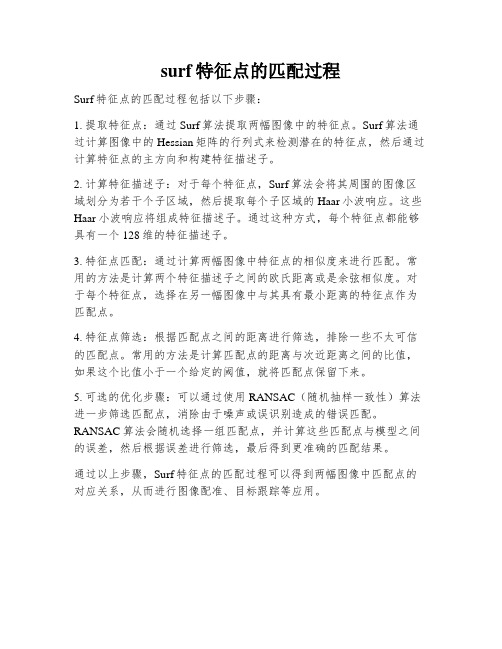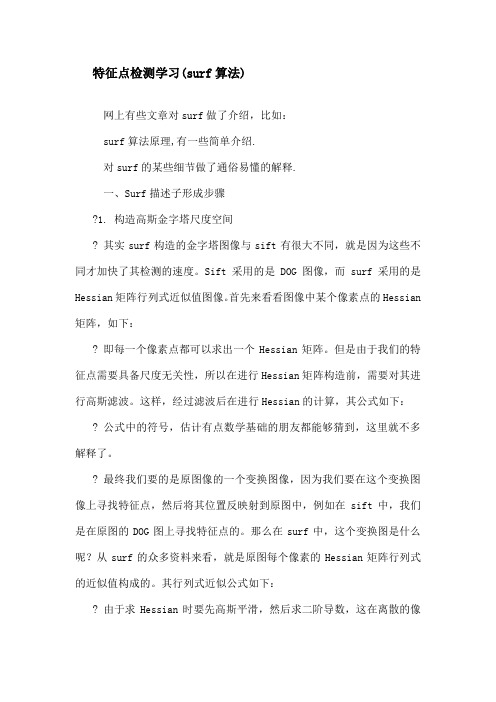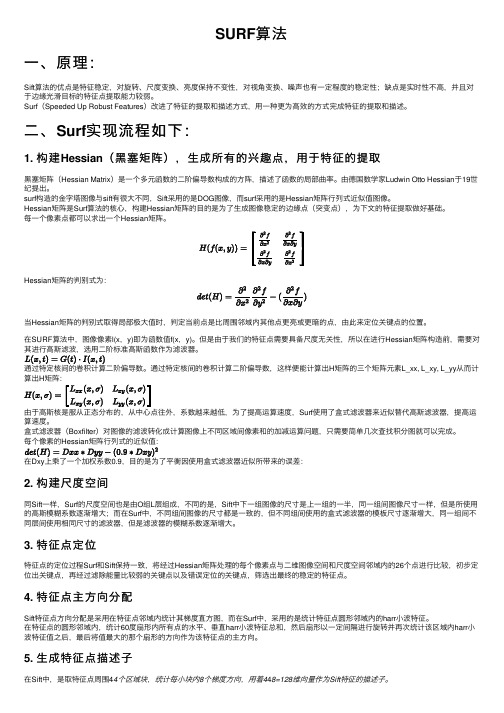surf算法
surf特征点的匹配过程

surf特征点的匹配过程
Surf特征点的匹配过程包括以下步骤:
1. 提取特征点:通过Surf算法提取两幅图像中的特征点。
Surf算法通过计算图像中的Hessian矩阵的行列式来检测潜在的特征点,然后通过计算特征点的主方向和构建特征描述子。
2. 计算特征描述子:对于每个特征点,Surf算法会将其周围的图像区域划分为若干个子区域,然后提取每个子区域的Haar小波响应。
这些Haar小波响应将组成特征描述子。
通过这种方式,每个特征点都能够具有一个128维的特征描述子。
3. 特征点匹配:通过计算两幅图像中特征点的相似度来进行匹配。
常用的方法是计算两个特征描述子之间的欧氏距离或是余弦相似度。
对于每个特征点,选择在另一幅图像中与其具有最小距离的特征点作为匹配点。
4. 特征点筛选:根据匹配点之间的距离进行筛选,排除一些不太可信的匹配点。
常用的方法是计算匹配点的距离与次近距离之间的比值,如果这个比值小于一个给定的阈值,就将匹配点保留下来。
5. 可选的优化步骤:可以通过使用RANSAC(随机抽样一致性)算法进一步筛选匹配点,消除由于噪声或误识别造成的错误匹配。
RANSAC算法会随机选择一组匹配点,并计算这些匹配点与模型之间的误差,然后根据误差进行筛选,最后得到更准确的匹配结果。
通过以上步骤,Surf特征点的匹配过程可以得到两幅图像中匹配点的对应关系,从而进行图像配准、目标跟踪等应用。
机器视觉中基于SURF算法的目标识别研究

机器视觉中基于SURF算法的目标识别研究第一章:引言随着计算机技术的不断发展,机器视觉技术逐渐应用于各种领域。
其中,目标识别是机器视觉技术的重要应用之一,可以在自动控制、工业制造、军事等领域中发挥重要作用。
在目标识别中,特征点检测和匹配是关键技术。
SURF算法是一种快速有效的特征点检测和匹配算法,已经得到广泛应用。
本文将介绍机器视觉中基于SURF算法的目标识别研究,具体包括SURF算法原理、SURF算法在目标识别中的应用及其优劣势分析、SURF算法在实际系统中的应用及其发展趋势等。
第二章:SURF算法原理SURF算法是加速稳健特征(Speeded Up Robust Feature)的缩写。
它是基于尺度空间理论的特征点检测和匹配算法。
SURF算法主要包括三个步骤:尺度空间构建、特征点检测和特征描述。
尺度空间构建是指先将原始图像进行高斯滤波,得到不同尺度下的图像金字塔,然后通过差分的方式得到尺度不变的DoG (Difference of Gaussian)图像组。
特征点检测是指在DoG图像组中检测出极值点,SURF算法中采用的是Hessian矩阵。
特征描述是指在检测到的特征点周围的邻域内,计算一组具有较强区分度的局部特征描述子,SURF算法中采用的是基于积分图像的Haar小波特征描述子。
第三章:SURF算法在目标识别中的应用及其优劣势分析SURF算法在目标识别中的应用主要包括两个方面:特征点检测和匹配。
特征点检测是指在图像中寻找具有独特性、稳定性和可重复性的特征点,SURF算法对尺度空间建立和特征点检测都有良好的性能,能够有效地检测到目标物体中的关键点。
匹配是指在两个图像中寻找相似的特征点,SURF算法具有较高的匹配准确率和速度,能够实现快速准确地目标匹配。
但是,SURF算法也存在一些不足之处,比如对图像旋转、缩放、变形等变化不够鲁棒,需要额外的操作来进行补偿。
第四章:SURF算法在实际系统中的应用及其发展趋势SURF算法在实际系统中的应用非常广泛,例如在工业机器人、自动驾驶、安防监控等领域中都得到了应用。
SURF算法分析ppt课件

最新编辑ppt
23
•
•
(3.1)
•
(3.2)
• •
最新编辑ppt
31
最后总结
• Stitching函数不足之处:在拼接过程中 如遇到图像特征不明显,如一面墙的图 片,则无法采集到有用的特征点,在采 用此方法过程中会出现越界现象。
最新编辑ppt
32
•Thank you for your attention!
最新编辑ppt
33
最新编辑ppt
最新编辑ppt
15
标出特征点的图像
最新编辑ppt
16
二.特征点 匹配
最新编辑ppt
17
特征点匹配
步骤1. 在检测特征点的过程中,计算了 Hessian 矩阵
的行列式,与此同时,计算得到了 Hessian 矩阵的迹,矩
阵的迹为对角元素之和。
按照亮度的不同,可以将特征点分为两种,第一种为
特征点及其周围小邻域的亮度比背景区域要亮,Hessian
变
化
量
51
99 147 195
6*n
27
51 75 99
Octaves
15
27 39 51
构建尺
9
15 21 27
变化量 n*6 度空间
Scale
最新编辑ppt
11
1.6极值点抑制
为了在目标影像上确定SURF特征点,我们使用了 3*3*3的模板在3维尺度空间进行非最大化抑制,根据 预设的Hessian阈值H,当h大于H,而且比临近的26个 点的响应值都大的点才被选为兴趣点。最后进行插值 精确。
图像特征点提取及匹配算法研究论文

图像特征点提取及匹配算法研究论文1.SIFT算法:SIFT(Scale-Invariant Feature Transform)算法是一种经典的图像特征点提取算法。
该算法首先使用高斯滤波器对图像进行多尺度的平滑处理,然后使用差分算子来检测图像中的关键点,最后计算关键点的主方向和描述符。
SIFT算法具有尺度不变性和旋转不变性,对于图像中存在较大尺度和角度变化的情况下仍能提取出稳定的特征点。
2.SURF算法:SURF(Speeded Up Robust Features)算法是一种快速的特征点提取算法,它在SIFT算法的基础上进行了优化。
SURF算法使用Haar小波响应来检测图像中的特征点,并使用积分图像来加速计算过程。
此外,SURF算法还使用了一种基于方向直方图的特征描述方法,能够提取出具有旋转不变性和尺度不变性的特征点。
3.ORB算法:ORB(Oriented FAST and Rotated BRIEF)算法是一种快速的特征点提取和匹配算法。
该算法结合了FAST角点检测算法和BRIEF描述符算法,并对其进行了改进。
ORB算法利用灰度值的转折点来检测图像中的角点,并使用二进制字符串来描述关键点,以提高特征点的匹配速度。
ORB算法具有较快的计算速度和较高的匹配精度,适用于实时应用。
4.BRISK算法:BRISK(Binary Robust Invariant Scalable Keypoints)算法是一种基于二进制描述符的特征点提取和匹配算法。
该算法首先使用田字形格点采样方法检测关键点,然后使用直方图来描述关键点的方向和纹理特征。
最后,BRISK算法使用二进制字符串来表示关键点的描述符,并使用汉明距离来进行特征点的匹配。
BRISK算法具有较快的计算速度和较高的鲁棒性,适用于大规模图像匹配任务。
总结起来,图像特征点提取及匹配算法是计算机视觉领域中的重要研究方向。
本文介绍了一些常用的特征点提取及匹配算法,并对其进行了讨论。
S U R F 算 法

特征点检测学习(surf算法)网上有些文章对surf做了介绍,比如:surf算法原理,有一些简单介绍.对surf的某些细节做了通俗易懂的解释.一、Surf描述子形成步骤1. 构造高斯金字塔尺度空间其实surf构造的金字塔图像与sift有很大不同,就是因为这些不同才加快了其检测的速度。
Sift采用的是DOG图像,而surf采用的是Hessian矩阵行列式近似值图像。
首先来看看图像中某个像素点的Hessian 矩阵,如下:即每一个像素点都可以求出一个Hessian矩阵。
但是由于我们的特征点需要具备尺度无关性,所以在进行Hessian矩阵构造前,需要对其进行高斯滤波。
这样,经过滤波后在进行Hessian的计算,其公式如下:公式中的符号,估计有点数学基础的朋友都能够猜到,这里就不多解释了。
最终我们要的是原图像的一个变换图像,因为我们要在这个变换图像上寻找特征点,然后将其位置反映射到原图中,例如在sift中,我们是在原图的DOG图上寻找特征点的。
那么在surf中,这个变换图是什么呢?从surf的众多资料来看,就是原图每个像素的Hessian矩阵行列式的近似值构成的。
其行列式近似公式如下:由于求Hessian时要先高斯平滑,然后求二阶导数,这在离散的像素点是用模板卷积形成的,这2中操作合在一起用一个模板代替就可以了,比如说y方向上的模板如下:该图的左边即用高斯平滑然后在y方向上求二阶导数的模板,为了加快运算用了近似处理,其处理结果如右图所示,这样就简化了很多。
并且右图可以采用积分图来运算,大大的加快了速度,关于积分图的介绍,可以去查阅相关的资料。
同理,x和y方向的二阶混合偏导模板如下所示:上面讲的这么多只是得到了一张近似hessian行列式图,这例比sift中的DOG图,但是在金字塔图像中分为很多层,每一层叫做一个octave,每一个octave中又有几张尺度不同的图片。
在sift算法中,同一个octave层中的图片尺寸(即大小)相同,但是尺度(即模糊程度)不同,而不同的octave层中的图片尺寸大小也不相同,因为它是由上一层图片降采样得到的。
SURF算法在图像处理中的应用

SURF算法在图像处理中的应用SURF算法是一种被广泛应用于计算机视觉领域的算法,其全称是Speeded Up Robust Features。
它是一种特征提取算法,可以在图像中检测出具有特殊性质的关键点,并生成具有鲁棒性的特征描述子。
这些特征可以用于识别相似的图像,比较相似度,并在图像配准、图像跟踪、三维重建等领域中发挥重要作用。
本文将探讨SURF算法在图像处理中的应用。
一、 SURF算法的原理SURF算法是基于SIFT算法的一种改进,它的主要优势在于速度更快、鲁棒性更强。
下面简单介绍SURF算法的原理。
1. 尺度空间构建SURF算法首先对原始图像进行尺度变换,通过高斯金字塔来构建尺度空间。
尺度空间的不同层次可以检测到不同大小的特征。
通过不同层次检测的关键点可以估计出原始图像中的关键点,这个过程被称为尺度空间极值点检测。
2. 关键点定位在尺度空间中,SURF算法通过Hessian矩阵的行列式求解得到图像局部极值点位置,这些点是具有高强度、对光照变化鲁棒等性质的关键点。
3. 方向确定为了使SURF算法对旋转和光照变化更加鲁棒,需要为每个关键点确定一个主方向,这个方向是在关键点周围采用Hessian矩阵主方向确定的。
4. 特征描述为了描述关键点的局部特征,SURF算法使用了一种统计学上的方法,即将关键点周围的区域分解成小的子区域,每个子区域在水平和竖直方向上计算Haar小波变换,形成特征向量。
这些特征向量组成的特征描述子具有鲁棒性,可以用来评估关键点的稳定性。
5. 特征匹配在进行图像匹配时,SURF算法使用了一种快速的近似最近邻搜索方法,称为快速最近邻搜索(FLANN)。
它可以在大规模的特征库中快速找到与查询特征最相似的特征。
二、 SURF算法可以被广泛应用于图像处理中,下面介绍一些应用领域。
1. 图像配准SURF算法可以被用来匹配两幅图像之间的关键点,通过计算两幅图像中关键点的相似度来实现图像配准。
SURF算法

SURF算法⼀、原理:Sift算法的优点是特征稳定,对旋转、尺度变换、亮度保持不变性,对视⾓变换、噪声也有⼀定程度的稳定性;缺点是实时性不⾼,并且对于边缘光滑⽬标的特征点提取能⼒较弱。
Surf(Speeded Up Robust Features)改进了特征的提取和描述⽅式,⽤⼀种更为⾼效的⽅式完成特征的提取和描述。
⼆、Surf实现流程如下:1. 构建Hessian(⿊塞矩阵),⽣成所有的兴趣点,⽤于特征的提取⿊塞矩阵(Hessian Matrix)是⼀个多元函数的⼆阶偏导数构成的⽅阵,描述了函数的局部曲率。
由德国数学家Ludwin Otto Hessian于19世纪提出。
surf构造的⾦字塔图像与sift有很⼤不同,Sift采⽤的是DOG图像,⽽surf采⽤的是Hessian矩阵⾏列式近似值图像。
Hessian矩阵是Surf算法的核⼼,构建Hessian矩阵的⽬的是为了⽣成图像稳定的边缘点(突变点),为下⽂的特征提取做好基础。
每⼀个像素点都可以求出⼀个Hessian矩阵。
Hessian矩阵的判别式为:当Hessian矩阵的判别式取得局部极⼤值时,判定当前点是⽐周围邻域内其他点更亮或更暗的点,由此来定位关键点的位置。
在SURF算法中,图像像素l(x,y)即为函数值f(x,y)。
但是由于我们的特征点需要具备尺度⽆关性,所以在进⾏Hessian矩阵构造前,需要对其进⾏⾼斯滤波,选⽤⼆阶标准⾼斯函数作为滤波器。
H矩阵的三个矩阵元素L_xx, L_xy, L_yy从⽽计算出H矩阵:Surf使⽤了盒式滤波器来近似替代⾼斯滤波器,提⾼运算速度。
盒式滤波器(Boxfilter)对图像的滤波转化成计算图像上不同区域间像素和的加减运算问题,只需要简单⼏次查找积分图就可以完成。
每个像素的Hessian矩阵⾏列式的近似值:2. 构建尺度空间同Sift⼀样,Surf的尺度空间也是由O组L层组成,不同的是,Sift中下⼀组图像的尺⼨是上⼀组的⼀半,同⼀组间图像尺⼨⼀样,但是所使⽤的⾼斯模糊系数逐渐增⼤;⽽在Surf中,不同组间图像的尺⼨都是⼀致的,但不同组间使⽤的盒式滤波器的模板尺⼨逐渐增⼤,同⼀组间不同层间使⽤相同尺⼨的滤波器,但是滤波器的模糊系数逐渐增⼤。
SURF与FLANN算法结合的图像匹配方法

SURF与FLANN算法结合的图像匹配方法
SURF(Speeded Up Robust Features)是一种图像特征提取算法,FLANN(Fast Library for Approximate Nearest Neighbors)是一种快速最近邻搜索算法。
将这两种算法结合起来,可以实现高效准确的图像匹配。
图像匹配是指在一组图像中,找到与给定图像最相似的图像。
图像匹配在图像检索、
目标跟踪、增强现实等领域具有广泛的应用。
SURF算法对图像进行特征提取。
SURF算法通过检测图像中的关键点,并计算这些关键点的局部特征向量来描述图像。
SURF算法的特点是快速且具有稳定的鲁棒性,适用于各种图像变化情况。
接下来,FLANN算法将SURF提取的特征向量作为输入,构建一个近似最近邻搜索索引。
FLANN算法通过将特征向量映射到一个高维空间,并使用一种适合于高维空间的快速搜索
算法来找到与给定特征向量最相似的特征向量。
FLANN算法的特点是高效且具有较高的准
确性,适用于大规模的高维数据搜索。
通过计算匹配图像与给定图像之间的相似度,选取相似度最高的图像作为匹配结果。
相似度可以使用欧式距离、余弦相似度等度量方法进行计算。
选取相似度最高的图像作为
匹配结果,可以通过设置一个阈值进行筛选,只选择相似度超过阈值的图像。
图像匹配方法的优势在于可以处理图像的尺度、旋转、光照等变化,并具有较高的准
确性和鲁棒性。
将SURF与FLANN算法结合起来,不仅可以提高算法的速度和效率,还可以提高算法的准确性和鲁棒性。
这种图像匹配方法在实际应用中具有很大的潜力。
- 1、下载文档前请自行甄别文档内容的完整性,平台不提供额外的编辑、内容补充、找答案等附加服务。
- 2、"仅部分预览"的文档,不可在线预览部分如存在完整性等问题,可反馈申请退款(可完整预览的文档不适用该条件!)。
- 3、如文档侵犯您的权益,请联系客服反馈,我们会尽快为您处理(人工客服工作时间:9:00-18:30)。
1.2
1.2.1
Fast-Hessian Detector
The Hessian
The SURF detector is based on the determinant of the Hessian matrix. In order to motivate the use of the Hessian, we consider a continuous function of two variables such that the value of the function at (x, y ) is given by f (x, y ). The Hessian matrix, H , is the matrix of partial derivates of the function f .
1
SURF: Speeded Up Robust Features
In this section, the SURF detector-descriptor scheme is discussed in detail. First the algorithm is analysed from a theoretical standpoint to provide a detailed overview of how and why it works. Next the design and development choices for the implementation of the library are discussed and justified. During the implementation of the library, it was found that some of the finer details of the algorithm had been omitted or overlooked, so Section 1.5 serves to make clear the concepts which are not explicitly defined in the SURF paper [1].
i≤x j ≤y
I (x, y ) =
i=0 j =0
I (x, y )
(1)
Figure 1: Area computation using integral images Using the integral image, the task of calculating the area of an upright rectangular region is reduced four operations. If we consider a rectangle bounded by vertices A, B, C and D as in Figure 1, the sum of pixel intensities is calculated by: = A + D − (C + B ) (2)
2
det(H ) =
(4)
The value of the discriminant is used to classify the maxima and minima of the function by the second order derivative test. Since the determinant is the product of eigenvalues of the Hessian we can classify the points based on the sign of the result. If the determinant is negative then the eigenvalues have different signs and hence the point is not a local extremum; if it is positive then either both eigenvalues are positive or both are negative and in either case the point is classified as an extremum. Translating this theory to work with images rather than a continuous function is a fairly trivial task. First we replace the function values f (x, y ) by the image pixel intensities I (x, y ). Next we require a method to calculate the second order partial derivatives of the image. As described in Section ?? we can calculate derivatives by convolution with an appropriate kernel. In the case of SURF the second order scale normalised Gaussian is the chosen filter as it allows for analysis over scales as well as space (scale-space theory is discussed further later in this section). We can construct kernels for the Gaussian derivatives in x, y and combined xy direction such that we calculate the four entries of the Hessian matrix. Use of the Gaussian allows us to vary the amount of smoothing during the convolution stage so that the determinant is calculated at different scales. Furthermore, since the Gaussian is an isotropic (i.e. circularly symmetric) function, convolution with the kernel allows for rotation invariance. We can now calculate the Hessian matrix, H , as function of both space x = (x, y ) and scale σ .
H (x, σ ) =
Lxx (x, σ ) Lxy (x, σ ) Lxy (x, σ ) y (x, σ )
,
2
(5)
g (σ ) Here Lxx (x, σ ) refers to the convolution of the second order Gaussian derivative ∂ ∂x 2 with the image at point x = (x, y ) and similarly for Lyy and Lxy . These derivatives are known as Laplacian of Gaussians. Working from this we can calculate the determinant of the Hessian for each pixel in the image and use the value to find interest points. This variation of the Hessian detector is similar to that proposed by Beaudet [2]. Lowe [9] found performance increase in approximating the Laplacian of Gaussians by a difference of Gaussians. In a similiar manner, Bay [1] proposed an approximation to the Laplacian of Gaussians by using box filter representations of the respective kernels. Figure 2 illustrates the similarity between the discretised and cropped kernels and their box filter counterparts. Considerable performance increase is found when these filters are used in conjunction with the integral image described in Section 1.1. To qauntify the difference we can consider the number of array accesses and operations required in the convolution. For a 9 × 9 filter we would require 81 array accesses and operations for the original real valued filter and only 8 for the box filter representation. As the filter is increased in size, the computation cost increases significantly for the original Laplacian while the cost for the box filters is independent of size.
